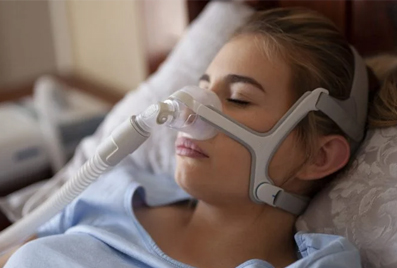Sleep Apnea
What is Sleep Apnea?
Sleep apnea is a sleeping disorder that can lead to severe health disorders such as heart diseases and hypertension. It is a condition where you abruptly and repeatedly stop and start breathing.
One of the common types of sleep apnea is Obstructive Sleep Apnea (OSA), a condition where the throat muscles relax and block the airways. It causes physical blockage in the airway and forces the diaphragm and the chest muscles to work harder. The OSA can reduce the flow of oxygen and cause irregular heart rhythms
Another type is the Central Sleep Apnea, a condition where the brain fails to send signals to breathe. It occurs due to a signaling instability of the central nervous system. You may stop breathing temporarily and then return with a deep breath, a snort, or a complete awakening with choking.
What are the causes of Sleep Apnea?
Obstructive sleep apnea is caused by physical airway blockage, where the muscles at the back of your throat relax and close the airway. In contrast, a central nervous system dysfunction causes central sleep apnea.
Other risk factors that contribute to sleep apnea include:
-
Nasal congestion
-
Excess fat thickening the tissues of the airway
-
Obesity
-
Thyroid
-
Heart and kidney failure
-
Swollen tonsils
-
Cold or allergies
What are the symptoms of Sleep Apnea?
People with sleep apnea may not notice the signs and symptoms initially; only their companion will. Symptoms of central and obstructive sleep apnea may overlap; even so, some of the common symptoms include:
-
Loud snoring
-
Restless sleeping
-
Episodes where the patient stopped breathing
-
Awakening by choking or gasping
-
Dry mouth and sore throat as they awake
-
Night sweats and morning headache
-
Mood disturbances like anxiety
-
Trouble concentrating
-
Heartburns
-
High blood pressure
-
Insomnia or hypersomnia
Diagnosis of Sleep Apnea
Based on your signs and symptoms, your physician will evaluate the severity of sleep apnea. They may recommend a sleep evaluation with a specialist or an overnight sleep study. Tests that help diagnose sleep apnea include:
-
Nocturnal Polysomnography: It is an overnight sleep study where you will be hooked to a machine. It will monitor and record various body functions like hand and leg movements, eye movements, heart rate, breathing pattern, air flow, brain’s electrical activity, etc.
-
Home Sleep Test: It is a sleep study that can be done from home, but it will only monitor and record fewer body functions than nocturnal polysomnography. It can confirm the diagnosis of obstructive sleep apnea. However, it should not be used for someone without symptoms.
Treatment for Sleep Apnea
The treatment for sleep apnea can depend on its severity and causes. For mild cases, physicians recommend lifestyle changes like low alcohol consumption, quitting smoking, a healthy diet, sleeping on the side, and weight management.
If there are no significant improvements, other methods of treatment would include therapy, medications, and in severe cases, surgery.
Some of the therapy methods would include:
-
Continuous positive airway pressure (CPAP)
-
Auto CPAP or Auto Bi-Level PAP
-
Adaptive servo-ventilation (ASV)
-
Supplemental oxygen
Surgical procedures for sleep apnea are suggested for people with severe malformed tissue that blocks the airway or for those whose other treatment methods have failed. Some of the methods include:
-
Tissue removal or uvulopalatopharyngoplasty
-
Somnoplasty
-
Nasal surgery
-
Tissue shrinkage
-
Tonsillectomy



